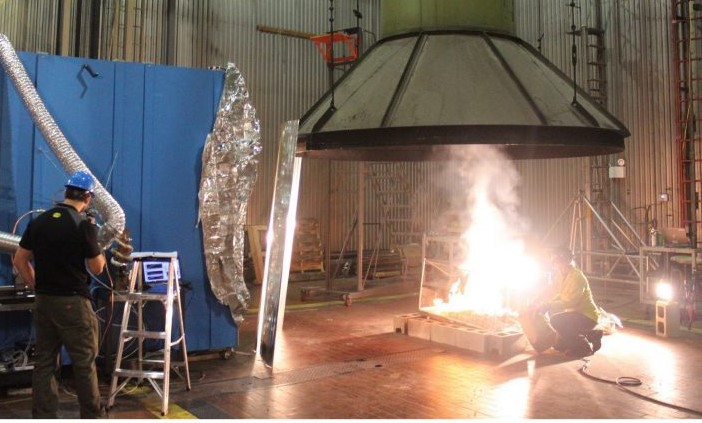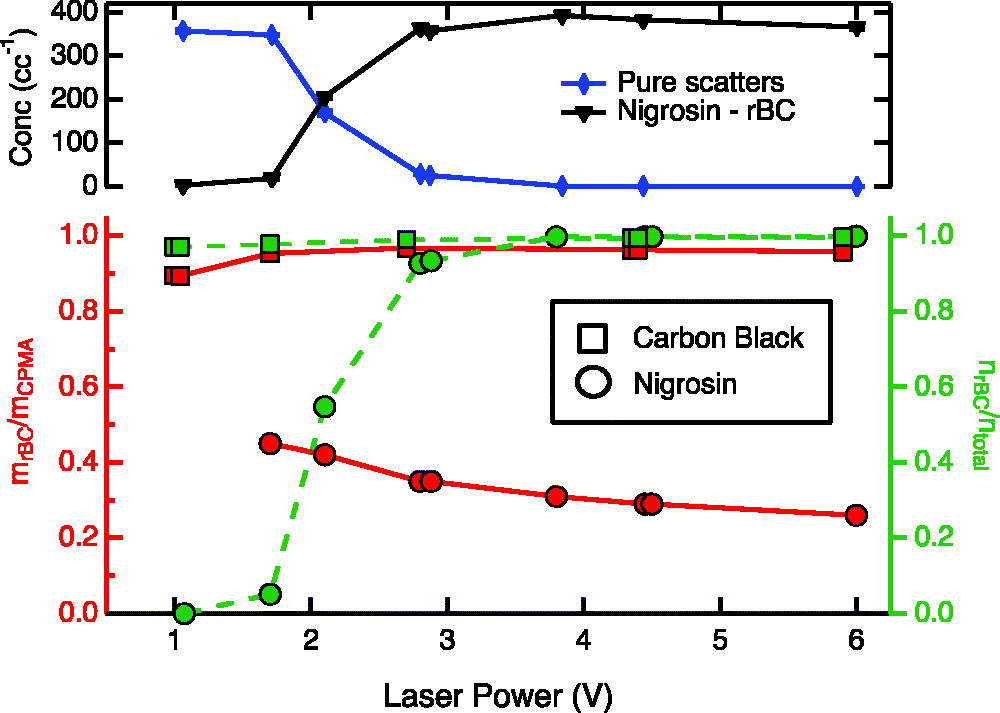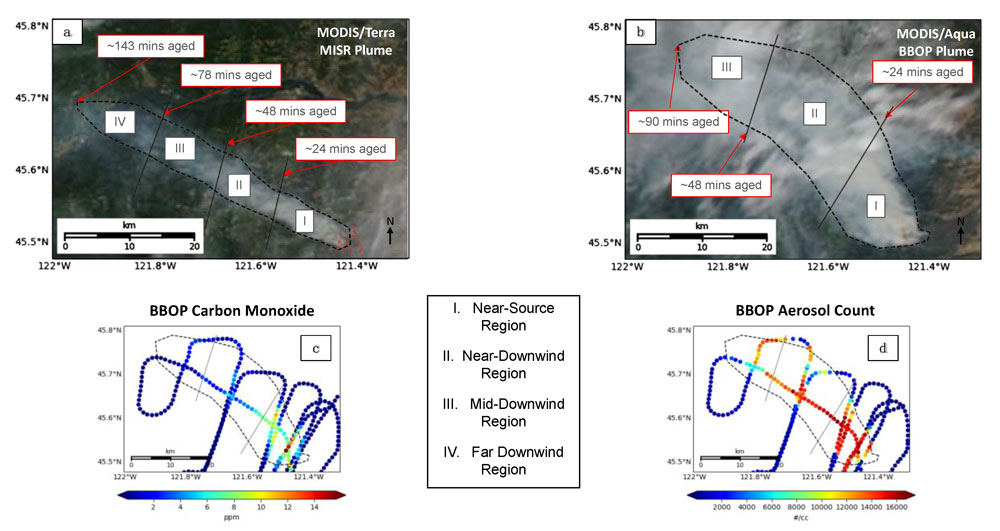Inside Job: Studying Smoke and Fire at a Laboratory Scale
Published: 21 October 2021
Airborne BBOP campaign inspires a slew of work in non-outdoor settings
Editor’s note: This article is part of a series exploring ARM field campaigns, research, and data on biomass burning events.

In the last two decades, the largest and most influential U.S. Department of Energy (DOE) study of wildland and agricultural fires is the 2013 Biomass Burning Observation Project (BBOP). Scientists investigated the evolution of near-field particulate emissions by flying a research aircraft above and within the smoke plumes of such blazes in the Pacific Northwest and Lower Mississippi Valley.
Conducted by the Atmospheric Radiation Measurement (ARM) user facility, BBOP prompted related studies at multiple agencies, created durable data sets, and inspired at least 30 papers and other studies. (BBOP data are freely available in the ARM Data Center.)
Much of the funding for campaign data analyses came from DOE’s Atmospheric System Research (ASR).
The need for such research is plain. Wildfires and other biomass burning events account for approximately 60% of carbon particles in the atmosphere. These particles influence the Earth’s energy balance, cloud formation, and precipitation. They also affect human health.
At the same time, the pressing need for biomass burning research is underscored by the increasing prevalence and intensity of wildfires, which annually consume millions of acres of forest and shrubland.
BBOP represents the kind of research that depends on observational data from active, outdoor, real-world settings. Because of its relatively long duration, attention to smoke-evolution time spans, and focus on U.S. wildfires, BBOP was a dramatically unique outdoor field campaign.
But BBOP was not just an outside job. The campaign is also linked to smoke-related research in non-outdoor settings: laboratories, the shops of those who design and build instruments, and the desktops of modelers creating simulations and analytical methods.
A Better Instrument
A report from a March 2020 ARM aerial instrumentation workshop included a white paper by BBOP Co-Principal Investigator Art Sedlacek, who is at Brookhaven National Laboratory in New York. He reported on the availability of a new compact, extended-range version of the single-particle soot photometer (SP2). The device uses a laser to heat an individual aerosol (here, a particle of black carbon, or soot) to the point of incandescence. Such “white heat” prompts the emission of electromagnetic radiation, which provides details on the targeted carbon particle, including data on mass, size, and coating.
The SP2 is “the only instrument that can directly detect and characterize individual (black carbon)-containing particles,” wrote Sedlacek.
The original, heavier BBOP model was a rack-mountable instrument. The newer SP2―yet to be used in an ARM field campaign―is designed for both long-term monitoring and deployment on small aerial platforms. Its small size allows for deployment scenarios not possible with the larger unit.
The new compact version of the SP2 offers “great potential aboard tethered balloon systems (TBS) by providing a direct, particle-resolved measurement of black carbon,” said Sedlacek.
Such a deployment, he added, could provide the first direct measurements of the vertical profile of light-absorbing black carbon concentrations from a TBS platform.
Laboratory Investigations

In March 2017, Sedlacek joined Timothy B. Onasch of Massachusetts-based Aerodyne Research Inc. in releasing a report on laboratory experiments using assets in Colorado and Montana. These experiments used an SP2 instrument similar to the one deployed during BBOP. The aim was to leverage controlled indoor settings to characterize emissions from heated fuels of the kind that feed wildfires in the Western United States.
The SP2 laboratory experiments, facilitated by an Aerodyne instrument module, took place at the U.S. Forest Service’s Fire Sciences Laboratory at the University of Montana and included instrumentation from Colorado State University. The experiments allowed measurements of the evolution of biomass burning particles to be compared with simulations in models developed by air-quality researcher Shantanu Jathar.
All this was part of the ongoing Fire Influence on Regional and Global Environments Experiment (FIREX), directed by NOAA.
ARM’s SP2 proved robust and reliable in laboratory settings. It produced data sets that will advance BBOP and FIREX data analysis, including the nature of fire-related emissions during the day and night.
Targeting Tarballs, Fixing Filters
Also in March 2017, Sedlacek and Onasch published a report on a laboratory BBOP spinoff experiment in the Boston College lab of chemist Paul Davidovits. The four-week effort involved the same instruments used on the BBOP research aircraft—ARM’s now-retired Gulfstream-159 (G-1).
The study focused on the chemical and optical properties of tarball particles and the efficiencies of instruments used to detect them.
Tarballs, spherical and organic, are brown carbonaceous particles that seem to be unique to biomass burning. Tarballs make up as much as 30% of the aerosol mass from wildfires and other burning events.
Brown carbon particles—light-absorbing organic aerosols in the atmosphere—are distinct from black carbon, which is often found in the atmosphere as fine particles.

In a 2018 paper led by Sedlacek, researchers reported on “SP2 laser-induced charring of brown carbon aerosol that could be misidentified as black carbon.” The laboratory work suggests that around 8% of wildfire tarballs can char in the SP2 and thus could lead to an overestimation of black carbon loadings in wildfire smoke plumes.
This “heretofore unidentified artifact of the SP2,” say the authors, is “an important source of error.” Black carbon absorbs light and is second only to carbon dioxide as a warming agent.
Another laboratory experiment, reported in a 2020 paper, used filters saved from nine BBOP flights. Led by Cary Presser of the National Institute of Standards and Technology in Maryland, the work compared new and traditional techniques of deriving light absorption of aerosols collected on a filter. It followed a 2017 study Presser led on transmissivity measurements of BBOP particle soot absorption photometer filter samples.
The authors showed general agreement between absorptivity results from the two techniques. But they also noted some differences in transmissivity measurements, which they attributed to possible changes in the aerosol properties during storage.
Thermal Properties
In 2017, Sedlacek and BBOP Co-PI Larry Kleinman co-authored a paper on the thermal properties of biomass-burn aerosols. Led by Japan-based researcher Kouji Adachi, the work looked at how aerosol particles respond to heating that happens during wildfires. To date, say the authors, not much is known about the thermal behavior of organic aerosol particles.
The authors devised a way to observe such thermal behavior, including the changes in shape, size, and chemical composition that heating caused. Starting at room temperature, they heated individual BBOP sample particles within a transmission electron microscope. The peak temperature reached more than 600 degrees Celsius (1,112 degrees Fahrenheit).
Results showed that, unlike bulk sample measurements, individual particles are a medley of organic matter types, each with different thermal stabilities.
The thermal stability of some particles renders them undetectable by many commonly used methods. As a consequence, say the authors, current regional and global climate models may underestimate the presence of tarballs and other organic particles. In other words, biomass burning may have more influence on the climate than is currently recognized.
Algorithms, Parameters, and Value-Added Products

Katherine Junghenn Noyes at the University of Maryland, College Park, led a 2020 study that used BBOP as an observational baseline to assess the strengths and limitations of a research aerosol retrieval algorithm used for the NASA Earth Observing System’s multi-angle imaging spectroradiometer. Using nine angles, the instrument captures multifaceted pictures of atmospheric particles, clouds, and land surfaces.
The authors found that the algorithm, once properly validated by BBOP data, appropriately mapped qualitative changes in effective particle size, light absorption, spectral dependence, and other factors when compared with in situ observations.
In another BBOP-related improvement, ARM released the Navigation and Meteorological Data from Multiple Sensors on Airborne Platform (NAVMET-AIR) value-added product in 2020. NAVMET-AIR includes read-me files for nine ARM field campaigns with prominent airborne components, including BBOP. It’s intended to provide a suite of tools to standardize instrument interfaces during airborne research.
A 2016 study demonstrated a new Ångström absorption exponent (AAE) method for distinguishing the absorption properties of brown carbon from black carbon. AAE is an important optical parameter for characterizing aerosols. It is especially important because there are considerable uncertainties related to observational estimates of carbon particles.
AAE measurements are needed to accurately retrieve aerosol optical depth measurements from satellite data. (Optical depth is the distribution of aerosols in the column, measured from the Earth’s surface to the top of the atmosphere.)
From investigating smoke plumes outdoors to probing minute smoke properties in laboratories to refining models, BBOP continues to inspire.
Keep up with the Atmospheric Observer
Updates on ARM news, events, and opportunities delivered to your inbox
ARM User Profile
ARM welcomes users from all institutions and nations. A free ARM user account is needed to access ARM data.


















